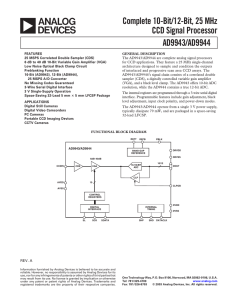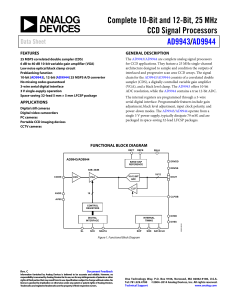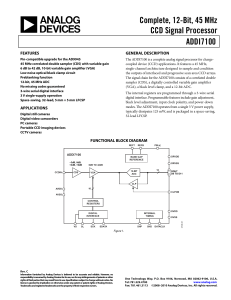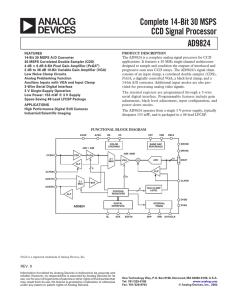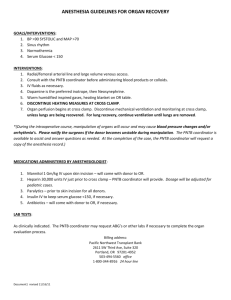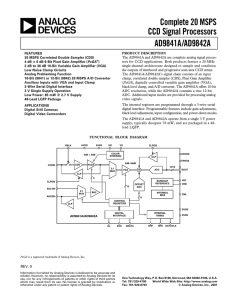Complete 12-Bit 40 MHz CCD Signal Processor AD9945
advertisement
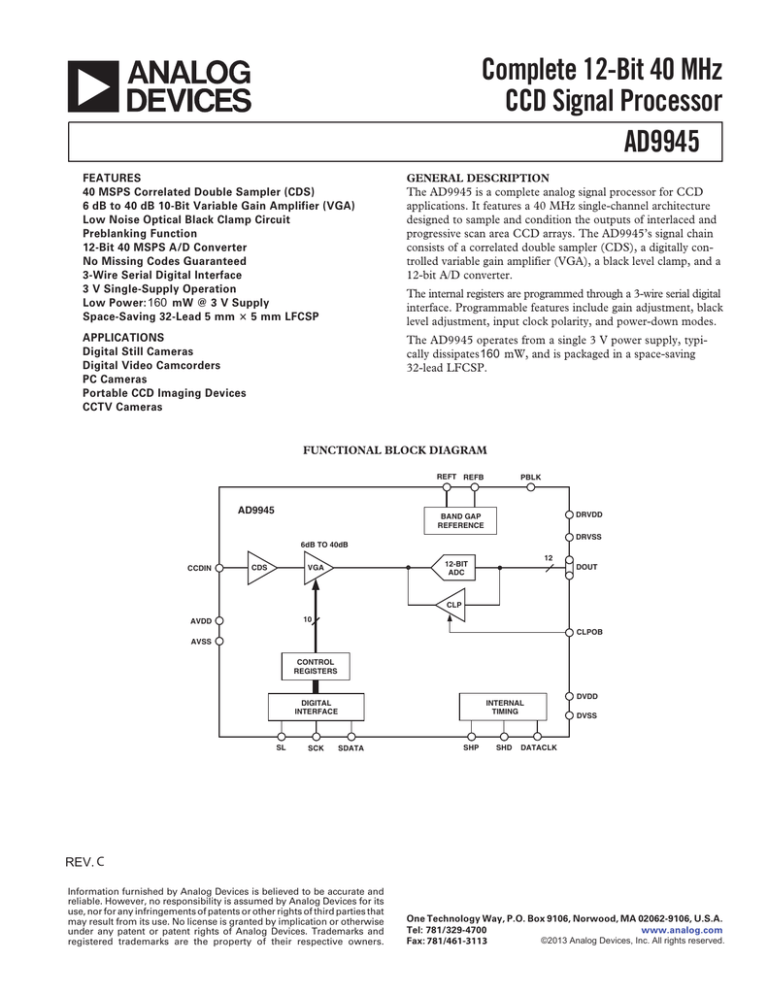
Complete 12-Bit 40 MHz CCD Signal Processor AD9945 FEATURES 40 MSPS Correlated Double Sampler (CDS) 6 dB to 40 dB 10-Bit Variable Gain Amplifier (VGA) Low Noise Optical Black Clamp Circuit Preblanking Function 12-Bit 40 MSPS A/D Converter No Missing Codes Guaranteed 3-Wire Serial Digital Interface 3 V Single-Supply Operation Low Power: 160 mW @ 3 V Supply Space-Saving 32-Lead 5 mm ⴛ 5 mm LFCSP GENERAL DESCRIPTION APPLICATIONS Digital Still Cameras Digital Video Camcorders PC Cameras Portable CCD Imaging Devices CCTV Cameras The AD9945 operates from a single 3 V power supply, typically dissipates 160 mW, and is packaged in a space-saving 32-lead LFCSP. The AD9945 is a complete analog signal processor for CCD applications. It features a 40 MHz single-channel architecture designed to sample and condition the outputs of interlaced and progressive scan area CCD arrays. The AD9945’s signal chain consists of a correlated double sampler (CDS), a digitally controlled variable gain amplifier (VGA), a black level clamp, and a 12-bit A/D converter. The internal registers are programmed through a 3-wire serial digital interface. Programmable features include gain adjustment, black level adjustment, input clock polarity, and power-down modes. FUNCTIONAL BLOCK DIAGRAM REFT REFB AD9945 PBLK DRVDD BAND GAP REFERENCE DRVSS 6dB TO 40dB CCDIN CDS 12 12-BIT ADC VGA DOUT CLP 10 AVDD CLPOB AVSS CONTROL REGISTERS INTERNAL TIMING DIGITAL INTERFACE SL SCK SDATA SHP SHD DVDD DVSS DATACLK REV. C Information furnished by Analog Devices is believed to be accurate and reliable. However, no responsibility is assumed by Analog Devices for its use, nor for any infringements of patents or other rights of third parties that may result from its use. No license is granted by implication or otherwise under any patent or patent rights of Analog Devices. Trademarks and registered trademarks are the property of their respective owners. One Technology Way, P.O. Box 9106, Norwood, MA 02062-9106, U.S.A. Tel: 781/329-4700 www.analog.com ©2013 Analog Devices, Inc. All rights reserved. Fax: 781/461-3113 AD9945–SPECIFICATIONS GENERAL SPECIFICATIONS (T MIN to TMAX, AVDD = DVDD = DRVDD= 3.0 V, fSAMP = 40 MHz, unless otherwise noted.) Parameter Min TEMPERATURE RANGE Operating Storage POWER SUPPLY VOLTAGE Analog, Digital, Digital Driver Typ Max Unit –20 –65 +85 +150 °C °C 2.85 3.6 V POWER CONSUMPTION Normal Operation (DRVDD Power not Included) DRVDD Power Only (CLOAD = 20 pF) Power-Down Mode MAXIMUM CLOCK RATE 160 mW mW mW 10 1.5 40 MHz Specifications subject to change without notice. DIGITAL SPECIFICATIONS (DRVDD = DVDD = 2.85 V, C L = 20 pF, unless otherwise noted.) Parameter Symbol Min LOGIC INPUTS High Level Input Voltage Low Level Input Voltage High Level Input Current Low Level Input Current Input Capacitance VIH VIL IIH IIL CIN 2.1 LOGIC OUTPUTS High Level Output Voltage, IOH = 2 mA Low Level Output Voltage, IOL = 2 mA VOH VOL 2.2 Typ Max 0.6 10 10 10 0.5 Unit V V μA μA pF V V Specifications subject to change without notice. –2– REV. C AD9945 SYSTEM SPECIFICATIONS (T MIN to TMAX , AVDD = DVDD = DRVDD = 3.0 V, fSAMP = 40 MHz, Register 0xD = 0x838, unless otherwise noted.) Parameter Min CDS Maximum Input Range before Saturation* Allowable CCD Reset Transient* Maximum CCD Black Pixel Amplitude* VARIABLE GAIN AMPLIFIER (VGA) Gain Control Resolution Gain Monotonicity Gain Range Minimum Gain Maximum Gain Low Gain Mode 1024 Guaranteed 40.0 5.3 41.5 ¦1.5 0 Vp-p mV mV See Input Waveform in Footnote dB dB +1.5 dB 256 Steps 0 255 LSB LSB 12 See Figure 7 for VGA Gain Curve See Variable Gain Amplifier section for VGA gain equation See Table 1, Internal Register Map, for register information Bits LSB ± 0.5 Guaranteed Straight Binary 2.0 V 2.0 1.0 V V Specifications Include Entire Signal Chain 40.0 5.3 41.5 ⴞ1.0 0.1 1.2 40 dB dB dB % LSB rms dB 500mV TYP RESET TRANSIENT 1V TYP INPUT SIGNAL RANGE Specifications subject to change without notice. REV. C Notes Steps *Input Signal Characteristics defined as follows: 100mV TYP OPTICAL BLACK PIXEL Unit Measured at ADC Output VOLTAGE REFERENCE Reference Top Voltage (REFT) Reference Bottom Voltage (REFB) SYSTEM PERFORMANCE Gain Range Low Gain (VGA Code = 0) Maximum Gain (VGA Code = 1023) Gain Accuracy Peak Nonlinearity, 500 mV Input Signal Total Output Noise Power Supply Rejection (PSR) Max 1.0 500 100 BLACK LEVEL CLAMP Clamp Level Resolution Clamp Level Minimum Clamp Level Maximum Clamp Level A/D CONVERTER Resolution Differential Nonlinearity (DNL) No Missing Codes Data Output Coding Full-Scale Input Voltage Typ –3– 12 dB Gain Applied AC Grounded Input, 6 dB Gain Applied AD9945 TIMING SPECIFICATIONS (C = 20 pF, f L SAMP = 40 MHz, CCD Mode Timing in Figures 8 and 9, Serial Timing in Figures 4 and 5.) Parameter Symbol Min SAMPLE CLOCKS DATACLK, SHP, SHD Clock Period DATACLK High/Low Pulse Width SHP Pulse Width SHD Pulse Width CLPOB Pulse Width* SHP Rising Edge to SHD Falling Edge SHP Rising Edge to SHD Rising Edge Internal Clock Delay tCONV tADC tSHP tSHD tCOB tS1 tS2 tID 25 10 DATA OUTPUTS Output Delay Pipeline Delay 2 11.25 tOD SERIAL INTERFACE Maximum SCK Frequency SL to SCK Setup Time SCK to SL Hold Time SDATA Valid to SCK Rising Edge Setup SCK Falling Edge to SDATA Valid Hold fSCLK tLS tLH tDS tDH Typ Max Unit 12.5 6.25 6.25 20 6.25 12.5 3 ns ns ns ns Pixels ns ns ns 9.5 10 ns Cycles 10 10 10 10 10 MHz ns ns ns ns *Minimum CLPOB pulse width is for functional operation only. Wider typical pulses are recommended to achieve low noise clamp performance. Specifications subject to change without notice. ABSOLUTE MAXIMUM RATINGS* Parameter AVDD DVDD DRVDD Digital Outputs SHP, SHD, DATACLK CLPOB, PBLK SCK, SL, SDATA REFT, REFB, CCDIN Junction Temperature Lead Temperature (10 sec) With Respect To Min Max AVSS DVSS DRVSS DRVSS DVSS DVSS DVSS AVSS –0.3 –0.3 –0.3 –0.3 –0.3 –0.3 –0.3 –0.3 +3.9 +3.9 +3.9 DRVDD + 0.3 DVDD + 0.3 DVDD + 0.3 DVDD + 0.3 AVDD + 0.3 150 300 Unit V V V V V V V V °C °C THERMAL CHARACTERISTICS Thermal Resistance 32-Lead LFCSP Package θJA = 27.7 °C/W *Stresses above those listed under Absolute Maximum Ratings may cause permanent damage to the device. This is a stress rating only; functional operation of the device at these or any other conditions outside of those indicated in the operational sections of this specification is not implied. Exposure to absolute maximum ratings for extended periods may affect device reliability. CAUTION ESD (electrostatic discharge) sensitive device. Electrostatic charges as high as 4000 V readily accumulate on the human body and test equipment and can discharge without detection. Although the AD9945 features proprietary ESD protection circuitry, permanent damage may occur on devices subjected to high energy electrostatic discharges. Therefore, proper ESD precautions are recommended to avoid performance degradation or loss of functionality. –4– REV. C AD9945 32 31 30 29 28 27 26 25 D1 D0 NC NC NC SCK SDATA SL PIN CONFIGURATION 1 2 3 4 5 6 7 8 PIN 1 INDICATOR AD9945 TOP VIEW 24 23 22 21 20 19 18 17 REFB REFT CCDIN AVSS AVDD SHD SHP CLPOB D10 9 D11 10 DRVDD 11 DRVSS 12 DVDD 13 DATACLK 14 DVSS 15 PBLK 16 D2 D3 D4 D5 D6 D7 D8 D9 NOTES 1. IT IS RECOMMENDED THAT THE EXPOSED PAD BE SOLDERED TO THE GROUND PLANE OF THE PCB. PIN FUNCTION DESCRIPTIONS Pin Number Mnemonic Type Description 1 to 10, 31, 32 11 12 13 14 15 16 17 18 19 20 21 22 23 24 25 26 27 28 to 30 D2 to D11, D0, D1 DRVDD DRVSS DVDD DATACLK DVSS PBLK CLPOB SHP SHD AVDD AVSS CCDIN REFT REFB SL SDATA SCK NC DO P P P DI P DI DI DI DI P P AI AO AO DI DI DI NC Digital Data Outputs Digital Output Driver Supply Digital Output Driver Ground Digital Supply Digital Data Output Latch Clock Digital Supply Ground Preblanking Clock Input Black Level Clamp Clock Input CDS Sampling Clock for CCD’s Reference Level CDS Sampling Clock for CCD’s Data Level Analog Supply Analog Ground Analog Input for CCD Signal A/D Converter Top Reference Voltage Decoupling A/D Converter Bottom Reference Voltage Decoupling Serial Digital Interface Load Pulse Serial Digital Interface Data Input Serial Digital Interface Clock Input Internally Pulled Down. Float or connect to GND. TYPE: AI = Analog Input, AO = Analog Output, DI = Digital Input, DO = Digital Output, P = Power. REV. C –5– AD9945 at the specified gain setting. The output noise can be converted to an equivalent voltage, using the relationship DEFINITIONS OF SPECIFICATIONS Differential Nonlinearity (DNL) An ideal ADC exhibits code transitions that are exactly 1 LSB apart. DNL is the deviation from this ideal value. Thus, every code must have a finite width. No missing codes guaranteed to 12-bit resolution indicates that all 4096 codes must be present over all operating conditions. 1 LSB = (ADC Full Scale/2N codes) where N is the bit resolution of the ADC. For the AD9945, 1 LSB is 0.5 mV. Power Supply Rejection (PSR) The PSR is measured with a step change applied to the supply pins. This represents a very high frequency disturbance on the AD9945’s power supply. The PSR specification is calculated from the change in the data outputs for a given step change in the supply voltage. Peak Nonlinearity Peak nonlinearity, a full signal chain specification, refers to the peak deviation of the output of the AD9945 from a true straight line. The point used as zero scale occurs 1/2 LSB before the first code transition. Positive full scale is defined as a level 1 1/2 LSB beyond the last code transition. The deviation is measured from the middle of each particular output code to the true straight line. The error is then expressed as a percentage of the 2 V ADC fullscale signal. The input signal is always appropriately gained up to fill the ADC’s full-scale range. Internal Delay for SHP/SHD The internal delay (also called aperture delay) is the delay that occurs from the time when a sampling edge is applied to the AD9945 until the actual sample of the input signal is held. Both SHP and SHD sample the input signal during the transition from low to high, so the internal delay is measured from each clock’s rising edge to the instant the actual internal sample is taken. Total Output Noise The rms output noise is measured using histogram techniques. The standard deviation of the ADC output codes is calculated in LSB and represents the rms noise level of the total signal chain EQUIVALENT INPUT CIRCUITS DVDD AVDD 330⍀ 60⍀ AVSS DVSS Figure 3. CCDIN (Pin 22) Figure 1. Digital Inputs—SHP, SHD, DATACLK, CLPOB, PBLK, SCK, SL, SDATA DVDD AVSS DRVDD DATA THREESTATE DOUT DVSS DRVSS Figure 2. Data Outputs—D0 to D11 –6– REV. C Typical Performance Characteristics–AD9945 1.0 180 0.5 VDD = 3.3 V 150 DNL (LSB) POWER DISSIPATION (mV) 165 VDD = 3.0 V 135 0 120 –0.5 105 90 25 32 SAMPLE RATE (MHz) –1.0 40 0 1600 2400 3200 CODE TPC 1. Power vs. Sampling Rate REV. C 800 TPC 2. Typical DNL Performance –7– 4000 AD9945 INTERNAL REGISTER DESCRIPTION Table I. Internal Register Map Register Name A3 A2 A1 A0 Address Bits Data Bits Function Operation 0 D0 D2, D1 D3 D5, D4 D6 Software Reset (0 = Normal Operation, 1 = Reset all registers to default) Power-Down Modes (00 = Normal Power, 01 = Standby, 10 = Total Shutdown) OB Clamp Disable (0 = Clamp ON, 1 = Clamp OFF) Test Mode. Should always be set to 00. PBLK Blanking Level (0 = Blank Output to Zero, 1 = Blank to OB Clamp Level) D8, D7 0 0 0 D11 to D9 Low Gain Mode. Normally set to 00. To enable low gain mode, set to 11. When low gain mode is enabled, VGA Gain register must be set to all zeroes. Test Mode. Should always be set to 000. 0 0 0 1 D0 D1 D2 D3 D4 D5 D6 D11 to D7 SHP/SHD Input Polarity (0 = Active Low, 1 = Active High) DATACLK Input Polarity (0 = Active Low, 1 = Active High) CLPOB Input Polarity (0 = Active Low, 1 = Active High) PBLK Input Polarity (0 = Active Low, 1 = Active High) Three-State Data Outputs (0 = Outputs Active, 1 = Outputs Three-Stated) Data Output Latching (0 = Latched by DATACLK, 1 = Latch is Transparent) Data Output Coding (0 = Binary Output, 1 = Gray Code Output) Test Mode. Should always be set to 00000. Clamp Level 0 0 1 0 D7 to D0 OB Clamp Level (0 = 0 LSB, 255 = 255 LSB) VGA Gain 0 0 1 1 D9 to D0 VGA Gain (0 = 6 dB, 1023 = 40 dB) Startup 1 1 0 1 D11 to D0 Required start-up write must be set to 0x838. Control NOTE: All register values default to 0x0000 at power-up except clamp level, which defaults to 128 decimal (128 LSB clamp level). –8– REV. C AD9945 SERIAL INTERFACE A0 SDATA A1 tDS A3 A2 D0 D1 D2 D3 D4 D5 D6 D7 D8 D9 D10 D11 tDH SCK tLS tLH SL NOTES 1. SDATA BITS ARE INTERNALLY LATCHED ON THE RISING EDGES OF SCK. 2. SYSTEM UPDATE OF LOADED REGISTERS OCCURS ON SL RISING EDGE. 3. ALL 12 DATA BITS D0 TO D11 MUST BE WRITTEN. IF THE REGISTER CONTAINS FEWER THAN 12 BITS, ZEROS SHOULD BE USED FOR THE UNDEFINED BITS. Figure 4. Serial Write Operation DATA FOR STARTING REGISTER ADDRESS SDATA SCK SL A0 1 A1 2 A2 3 A3 4 D0 5 D1 6 D2 7 D3 8 D4 9 DATA FOR NEXT REGISTER ADDRESS D5 10 ... ... ... D10 15 D11 16 D0 17 D1 18 ... ... D10 D11 27 28 ... NOTES 1. MULTIPLE SEQUENTIAL REGISTERS MAY BE LOADED CONTINUOUSLY. 2. THE FIRST (LOWEST ADDRESS) REGISTER ADDRESS IS WRITTEN, FOLLOWED BY MULTIPLE 12-BIT DATA-WORDS. 3. THE ADDRESS WILL AUTOMATICALLY INCREMENT WITH EACH 12-BIT DATA-WORD (ALL 12 BITS MUST BE WRITTEN). 4. SL IS HELD LOW UNTIL THE LAST DESIRED REGISTER HAS BEEN LOADED. 5. NEW DATA IS UPDATED AT THE NEXT SL RISING EDGE. Figure 5. Continuous Serial Write Operation to All Registers REV. C –9– D0 29 D1 30 D2 31 ... ... ... AD9945 DC RESTORE INTERNAL VREF 6dB TO 40dB 0.1F CCDIN 2V FULL SCALE VGA CDS 12 12-BIT ADC CLPOB OPTICAL BLACK CLAMP 8-BIT DAC 10 DOUT DIGITAL FILTERING VGA GAIN REGISTER 8 CLAMP LEVEL REGISTER Figure 6. CCD Mode Block Diagram CIRCUIT DESCRIPTION AND OPERATION The AD9945 signal processing chain is shown in Figure 6. Each processing step is essential in achieving a high quality image from the raw CCD pixel data. DC Restore To reduce the large dc offset of the CCD output signal, a dc restore circuit is used with an external 0.1 μF series coupling capacitor. This restores the dc level of the CCD signal to approximately 1.5 V to be compatible with the 3 V single supply of the AD9945. Correlated Double Sampler The CDS circuit samples each CCD pixel twice to extract the video information and reject low frequency noise. The timing shown in Figure 8 illustrates how the two CDS clocks, SHP and SHD, are used to sample the reference level and data level of the CCD signal, respectively. The CCD signal is sampled on the rising edges of SHP and SHD. Placement of these two clock signals is critical in achieving the best performance from the CCD. An internal SHP/SHD delay (tID) of 3 ns is caused by internal propagation delays. When the loop is disabled, the clamp level register may still be used to provide programmable offset adjustment. Horizontal timing is shown in Figure 9. The CLPOB pulse should be placed during the CCD’s optical black pixels. It is recommended that the CLPOB pulse be used during valid CCD dark pixels. The CLPOB pulse should be a minimum of 20 pixels wide to minimize clamp noise. Shorter pulse widths may be used, but clamp noise may increase and the loop’s ability to track low frequency variations in the black level will be reduced. A/D Converter The ADC uses a 2 V input range. Better noise performance results from using a larger ADC full-scale range. The ADC uses a pipelined architecture with a 2 V full-scale input for low noise performance. Variable Gain Amplifier The VGA stage provides a gain range of 6 dB to 40 dB, programmable with 10-bit resolution through the serial digital interface. The minimum gain of 6 dB is needed to match a 1 V input signal with the ADC full-scale range of 2 V. A plot of the VGA gain curve is shown in Figure 7. VGA Gain(dB) = (VGA Code × 0.035 dB) + 5.3 dB Optical Black Clamp The optical black clamp loop is used to remove residual offsets in the signal chain and to track low frequency variations in the CCD’s black level. During the optical black (shielded) pixel interval on each line, the ADC output is compared with the fixed black level reference, selected by the user in the clamp level register. The resulting error signal is filtered to reduce noise, and the correction value is applied to the ADC input through a D/A converter. Normally, the optical black clamp loop is turned on once per horizontal line, but this loop can be updated more slowly to suit a particular application. If external digital clamping is used during the postprocessing, the AD9945 optical black clamping may be disabled using Bit D3 in the operation register (see the Serial Interface Timing and Internal Register Description sections). 42 VGA GAIN (dB) 36 30 24 18 12 6 0 127 255 383 511 639 767 VGA GAIN REGISTER CODE 895 1023 Figure 7. VGA Gain Curve –10– REV. C AD9945 CCD MODE TIMING CCD SIGNAL N tID N+1 N+2 N+9 N+10 tID SHP tS1 tS2 tCP SHD DATACLK tOD OUTPUT DATA N–10 N– 9 N– 8 N– 1 N NOTES 1. RECOMMENDED PLACEMENT FOR DATACLK RISING EDGE IS BETWEEN THE SHD RISING EDGE AND NEXT SHP FALLING EDGE. 2. CCD SIGNAL IS SAMPLED AT SHP AND SHD RISING EDGES. Figure 8. CCD Mode Timing EFFECTIVE PIXELS HORIZONTAL BLANKING OPTICAL BLACK PIXELS DUMMY PIXELS EFFECTIVE PIXELS CCD SIGNAL CLPOB PBLK OUTPUT DATA EFFECTIVE PIXEL DATA OB PIXEL DATA DUMMY BLACK NOTES 1. CLPOB WILL OVERWRITE PBLK. PBLK WILL NOT AFFECT CLAMP OPERATION IF OVERLAPPING WITH CLPOB. 2. PBLK SIGNAL IS OPTIONAL. 3. DIGITAL OUTPUT DATA WILL BE ALL ZEROS DURING PBLK. OUTPUT DATA LATENCY IS NINE DATACLK CYCLES. Figure 9. Typical CCD Mode Line Clamp Timing REV. C –11– EFFECTIVE DATA AD9945 APPLICATIONS INFORMATION The AD9945 is a complete analog front end (AFE) product for digital still camera and camcorder applications. As shown in Figure 10, the CCD image (pixel) data is buffered and sent to the AD9945 analog input through a series input capacitor. The AD9945 performs the dc restoration, CDS, gain adjustment, black level correction, and analog-to-digital conversion. The AD9945’s digital output data is then processed by the image processing ASIC. The internal registers of the AD9945—used to control gain, offset level, and other functions—are programmed by the ASIC or microprocessor through a 3-wire serial digital interface. A system timing generator provides the clock signals for both the CCD and the AFE. AD9945 CCD VOUT ADCOUT 0.1F CCDIN REGISTERDATA BUFFER DIGITAL OUTPUTS SERIAL INTERFACE DIGITAL IMAGE PROCESSING ASIC CDS/CLAMP TIMING V-DRIVE CCD TIMING TIMING GENERATOR Figure 10. System Applications Diagram –12– REV. C AD9945 Internal Power-On Reset Circuitry After power-on, the AD9945 will automatically reset all internal registers and perform internal calibration procedures. This takes approximately 1 ms to complete. During this time, normal clock signals and serial write operations may occur. However, serial register writes will be ignored until the internal reset operation is completed. provide the lowest possible impedance path between the power and bypass pins and their respective ground pins. All decoupling capacitors should be located as close as possible to the package pins. A single clean power supply is recommended for the AD9945, but a separate digital driver supply may be used for DRVDD (Pin 11). DRVDD should always be decoupled to DRVSS (Pin 12), which should be connected to the analog ground plane. If the digital outputs (Pins 1 to 10, 31, and 32) must drive a load larger than 20 pF, buffering is recommended to reduce digital code transition noise. Alternatively, placing series resistors close to the digital output pins may also help reduce noise. Required Start-Up Write During power-up of the AD9945, 0x838 must be written into Register 0xD for proper start-up operation. Grounding and Decoupling Recommendations As shown in Figure 11, a single ground plane is recommended for the AD9945. This ground plane should be as continuous as possible. This will ensure that all analog decoupling capacitors 3 NC SCK SDATA SL 28 27 26 25 SERIAL INTERFACE 5 D7 6 D8 7 D9 8 D10 DATA OUTPUTS NC NC 29 TOP VIEW (Not to Scale) DVSS 15 D6 AD9945 24 REFB 1.0F 23 REFT 1.0F 22 CCDIN 21 AVSS 20 AVDD 19 SHD 18 SHP 17 CLPOB 0.1F CCDIN 0.1F 12 5 3V DRIVER SUPPLY 3V ANALOG SUPPLY PBLK 16 4 DATACLK 14 D5 DVDD 13 3 DRVSS 12 D4 PIN 1 IDENTIFIER DRVDD 11 2 9 1 D3 D11 10 D2 31 32 D1 30 D0 CLOCK INPUTS 3V ANALOG SUPPLY 0.1F 0.1F NC = NO CONNECT NOTE THE EXPOSED PAD ON THE BOTTOM OF THE AD9945 SHOULD BE SOLDERED TO THE GND PLANE OF THE PRINTED CIRCUIT BOARD Figure 11. Recommended Circuit Configuration for CCD Mode REV. C –13– AD9945 OUTLINE DIMENSIONS 5.10 5.00 SQ 4.90 32 25 0.50 BSC TOP VIEW 0.80 0.75 0.70 8 16 9 BOTTOM VIEW 0.05 MAX 0.02 NOM COPLANARITY 0.08 0.20 REF SEATING PLANE 3.25 3.10 SQ 2.95 EXPOSED PAD 17 0.50 0.40 0.30 PIN 1 INDICATOR 1 24 0.25 MIN FOR PROPER CONNECTION OF THE EXPOSED PAD, REFER TO THE PIN CONFIGURATION AND FUNCTION DESCRIPTIONS SECTION OF THIS DATA SHEET. COMPLIANT TO JEDEC STANDARDS MO-220-WHHD. 112408-A PIN 1 INDICATOR 0.30 0.25 0.18 Figure 12. 32-Lead Lead Frame Chip Scale Package [LFCSP_WQ] 5 mm × 5 mm Body, Very Very Thin Quad (CP-32-7) Dimensions shown in millimeters ORDERING GUIDE Model1 AD9945KCPZ AD9945KCPZRL7 1 Temperature Range −20°C to +85°C −20°C to +85°C Package Description 32-Lead Lead Frame Chip Scale Package [LFCSP_WQ] 32-Lead Lead Frame Chip Scale Package [LFCSP_WQ] Package Option CP-32-7 CP-32-7 Z = RoHS Compliant Part. REVISION HISTORY 5/13—Rev. B to Rev. C Updated Outline Dimensions ........................................................14 Changes to Ordering Guide ...........................................................14 1/11—Rev. A to Rev. B Changed 140 mW to 160 mW Throughout .................................. 1 Changes to Power Supply Voltage Parameter and Power Consumption, Normal Operation (DRVDD Power not Included) Parameter in General Specifications Table .................. 2 Changed 2.7 V to 2.85 V in Digital Specifications Table Summary ............................................................................................ 2 Changes to System Specifications Table Summary ....................... 3 Added Low Gain Mode Parameter in System Specifications Table .................................................................................................... 3 Added Exposed Pad Notation to Pin Configuration .................... 5 Changes to TPC 1.............................................................................. 7 Changes to Table 1 ............................................................................ 8 Changes to Figure 4 and Figure 5 ................................................... 9 Added Required Start-Up Write Section ..................................... 13 Changes to Grounding and Decoupling Recommendations Section .............................................................................................. 13 Moved Ordering Guide .................................................................. 14 Changes to Ordering Guide ........................................................... 14 11/03—Rev. 0 to Rev. A Changes to Timing Specifications................................................... 4 Changes to Ordering Guide ............................................................. 4 Changes to Figure 11 ...................................................................... 13 Updated Outline Dimensions........................................................ 14 ©2013 Analog Devices, Inc. All rights reserved. Trademarks and registered trademarks are the property of their respective owners. D03636-0-5/13(C) Rev. C | Page 14 of 14
